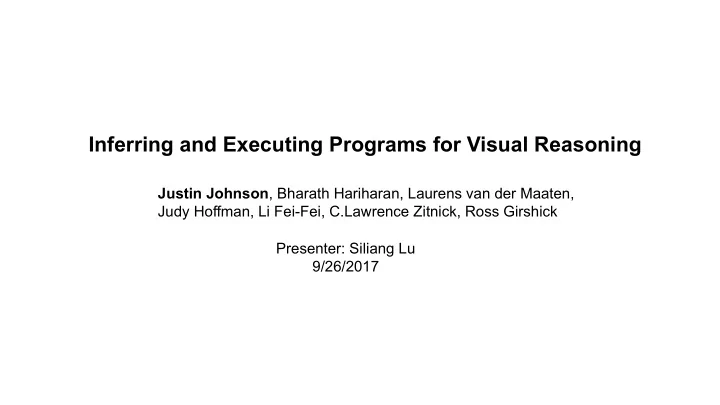

Inferring and Executing Programs for Visual Reasoning Justin Johnson , Bharath Hariharan, Laurens van der Maaten, Judy Hoffman, Li Fei-Fei, C.Lawrence Zitnick, Ross Girshick Presenter: Siliang Lu 9/26/2017
What is visual reasoning? • In order to deal with complex visual question answering, it might be necessary to explicitly incorporate compositional reasoning in the model. • I.e. Without having seen ”a person touching a bike”, the model should be able to understand the phrase by putting together its understanding of “ person ”, “ bike ” and “ touching ”. • Different from visual recognition where models learn direct input-output mappings to learn dataset biases
What is visual reasoning? • Inputs: An image x and a visual question q about the image • Intermediate outputs: A predicted program z = 𝜌(𝑟) representing the reasoning steps required to answer the question and an execution engine 𝜚 𝑦, 𝑨 executing the program on the image to predict an answer • Output: An answer a ∈ 𝐵 to the question from a fixed set A of possible answers Program generator z and execution engine 𝝔
Innovations compared with state-of-arts • Module network: a syntactic parse of a question to determine the architecture of the network Existing research: hand-designed off-the-shelf syntactic parser Current research: a learnt program generator that can adapt to the task at hand • Semantic parser Existing research: the semantics of the program and the execution engine are fixed and known a priori Current research: learn both the program generator and the execution engine • Program-induction methods Existing research: the interpretation of neural program considers only simple algorithms and program-induction assumes knowledge of the low-level operations Current research: the program generator consider inputs comprising an image and an associated question while assume minimal prior knowledge
What is program generator and execution engine? Programs: focused on learning semantics for a fixed syntax • Pre-specifying a set F of functions f , each of which has a fixed arity 𝑜 . = 1,2 • Including in the vocabulary a special constant Scene representing the visual features of the image • A valid program z is represented as syntax tress where each node contains a function f Execution engine: creating a neural network mapping to each function f • The program z is used to assemble a question-specific neural network composed from a set of modules • Generic architecture for all unary module, binary module and Scene module
Program generator Are there more cubes than yellow things? • LSTM sequence-to-sequence model • The resulting sequence of functions is converted to a syntax tree with prefix traversal • If the sequence is too short, we pad the sequence with Scene constants • If the sequence is too long, unused functions are discarded
Execution engine • Scene module takes visual features as input with Are there more cubes than yellow things? CNN Syntax tree • The final feature map is flattened and passed into a multilayer perception classifier
Execution engine • Unary module Are there more cubes than yellow things? • Binary module Syntax tree
Execution engine
Training Separate training with ground-truth programs • Given VQA dataset containing ( x,q,z,a ) tuples with ground truth z • Use pairs (q,z) of questions and corresponding programs to train the program generator • Use triplets (x,z,a) of the image, program, and answer to train the execution engine with backpropagation to compute the gradients Joint training without ground-truth programs • Use REINFORCE to estimate gradients on the outputs of the program generator. • The reward for each of its outputs is the negative zero-one loss of the execution engine, with a moving-average baseline.
Training Semi-supervised learning Program generator training with a small set of ground-truth programs REINFORCE Execution engine training with predicted programs based on the fixed program generator
Training
Experiments Generalizing to new attribute combinations
Experiments Generalizing to new attribute combinations Top 1 st column : • Train on A and test on A Top 2 nd column: • Train on A and test on B Top 3rd column: • Train A and finetune on B and test on A Top 4 th column: • Train A and finetune on B and test on B Bottom Figure 1: • Finetune on B and test on B with overall questions Bottom Figure 2: • Finetune on B and test on B with color-query Bottom Figure3: • Finetune on B and test on B with shape-query
Experiments Generalizing to new type of questions • Able to generalize to questions with program structures without observing associated ground-truth programs.
Experiments Human-composed questions
Future work • How to add new modules by automatically identifying and learning without supervision program? i.e. “What color is the object with a unique shape?” solution: a Turing-complete set of modules • Control-flow operators could be incorporated into the framework • Learning programs with limited supervision
Thanks!
Recommend
More recommend